Podstawy kuchni francuskiej, podział dań w menu, pomidory w puszce – to nieliczne z jego zasług. Auguste Escoffier, ikona i nieoceniony autorytet w zakresie gastronomii, którego zasługi powinien znać każdy człowiek ceniący sztukę kulinarną.
Chciałabym Ci opowiedzieć o postaci, którą każdy człowiek powinien znać. Dlaczego? Wytłumaczę Ci to na zasadzie skojarzeń.
Mikołaj Kopernik? Astronomia.
Krzysztof Kolumb? Odkrycie Ameryki.
Auguste Escoffier? I w tym momencie, każdy, jak jeden mąż, powinien powiedzieć – GASTRONOMIA.
Mówi się o nim: „King of Chefs and Chef of Kings”, czyli „Chef Królów i Król Chefów”. Podobno po raz pierwszy nazwał go tak cesarz Wilhelm II po tym, jak Escoffier podał jemu i 146 niemieckim dygnitarzom imponującą kolacją. Gratulując Escoffierowi posiłku, rzekomo wtedy powiedział: „Ja jestem cesarzem Niemiec, zaś Ty jesteś cesarzem szefów kuchni”.
Auguste Escoffier, urodzony we Francji w 1846 roku, rozpoczął przygodę z gotowaniem w wieku 12 lat w restauracji wujka w Nicei. W trakcie kariery gotował dla królów, prezydentów, wielu gwiazd Londyńskiej i Paryskiej Opery. Jednak tym, co wyróżnia go na tle innych kucharzy, są zmiany, które wprowadził do gastronomii i całej sztuki kulinarnej. Zanim na scenie gastronomicznej pojawił się Escoffier, kuchnia była zarezerwowana tylko dla bogatych i dominował w niej przepych – zarówno w zakresie formy podania dań, jak również ilości składników w serwowanych potrawach. Sosy były zbyt bogate, zbyt tłuste i miały zbyt wiele sprzecznych smaków. Escoffier bardzo wierzył w prostotę kuchni, dlatego za cel postawił sobie… kulinarną rewolucję!
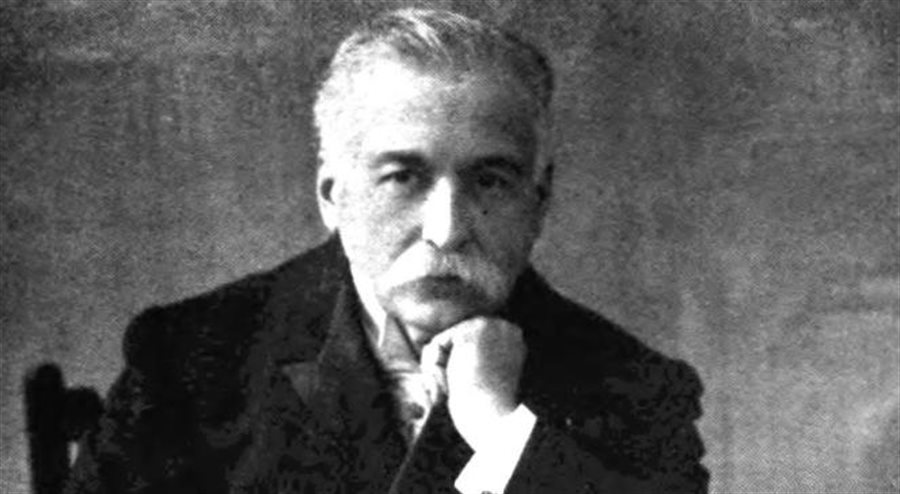
źródło: Wikipedia/Public Domain/The gourmet’s guide to London
Wśród dokonań Auguste Escoffiera znajdziemy:
1) „Brigade de Cuisine”, czyli hierarchia w kuchni
Auguste Escoffier doświadczenie zdobywał w trakcie wojny francusko-pruskiej, gdzie pełnił funkcję szefa kuchni przy sztabie generalnym. To właśnie z wojska zaczerpnął inspiracji do przeorganizowania pracy w kuchni. Tak jak np. poszczególni ministrowie podlegają Premierowi, tak poniżsi członkowie „Brygady” podlegają Szefowi Kuchni i jego zastępcy.
Kuchnie – wyjaśnił – potrzebują właściwej organizacji, dlatego stworzyłem system, nad którym wciąż pracuję, hierarchię, kolejność, Brigade de Cuisine. Zamiast kazać kucharzowi przygotowywać wszystkie elementy dania, podzieliłem kuchnię na określone strefy, z których każdą kieruje mistrz – Chef de Partie. Talerz przechodzi od jednego mistrza do drugiego, stopniowo się zapełniając. Któregoś dnia wszystkie kuchnie będą zorganizowane w ten sposób.
– „Białe Trufle” – N.M. Kelby
Członkowie „Brygady”:
Chef – jest odpowiedzialny za całą kuchnię, przygotowuje menu i kieruje wszystkim, co dzieje się w jego kuchni.
Sous Chef – „sous” (z języka francuskiego) oznacza „pod”, czyli zastępcę. Przyjmuje zadania bezpośrednio od Szefa Kuchni i zastępuje go, gdy nie jest na miejscu.
Chef de Partie – jest ich kilku. Każdy z nich jest odpowiedzialny za określone stanowisko w kuchni i osoby, które na nim pracują.
Cuisiniers – czyli kucharze. Odpowiedzialni za przygotowanie konkretnych potraw w określonych „stacjach”.
Commis – pomocnicy kucharza, którzy odpowiedzialni są głównie za dbanie o porządek na poszczególnych stanowiskach. Odpowiadają przed „Chef de Partie”.
Apprentice – uczniowie i praktykanci. Zazwyczaj zaliczani do pomocników kuchennych, którzy odpowiedzialni są za sprzątanie i przygotowanie stanowisk do pracy.
Powyższy podział do dziś występuje w najlepszych restauracjach na całym świecie.
źródło: ouest-france.fr
2) „Keep it simple”, czyli w prostocie siła
W czasach poprzedzających jego karierę, gotowanie polegało na skomplikowanych przepisach, ekstrawaganckich kolacjach i sosach, które całkowicie zmieniały (na niekorzyść) serwowane dania. Filozofią Escoffiera była prostota serwowania dań. Traktował je jak dzieła sztuki.
3) Zaczął przygotowywać dania o wysokiej wartości odżywczej.
Escoffier zdawał sobie sprawę z tego, że dania przygotowywane przez innych kucharzy w tym okresie były ciężkie i nie wpływały korzystnie na samopoczucie. Dlatego też całkowicie zmienił sposób kreowania dań, aby były nie tylko smaczne, lecz również pożywne!
4) Rozpoczął trend na wykorzystywanie sezonowych produktów od lokalnych producentów
Menu w restauracjach, którymi zarządzał, zmieniało się zgodnie z sezonami danych produktów, ponieważ dbał o jak najlepszą jakość serwowanych dań. Bazował głównie na świeżych produktach i pieczołowicie sprawdzał ich pochodzenie.
5) „Service à la russe”, czyli odejście od francuskiego przepychu
Escoffier odchodził od tradycyjnego, francuskiego serwowania dań (à la francaise), polegającego na serwowaniu wszystkich dań jednocześnie. Dzięki niemu, do dziś dania serwowane są w odpowiedniej kolejności i nie musimy jeść przystawki, dania głównego i deseru w tym samym czasie.
Zapewne kojarzysz ten przepych z filmów lub obrazów. Jednym z moich faworytów obrazujących przepych na stołach w dawnych czasach jest obraz “Uczta u Radziwiłłów” autorstwa Aleksandra Orłowskiego (1777-1832).
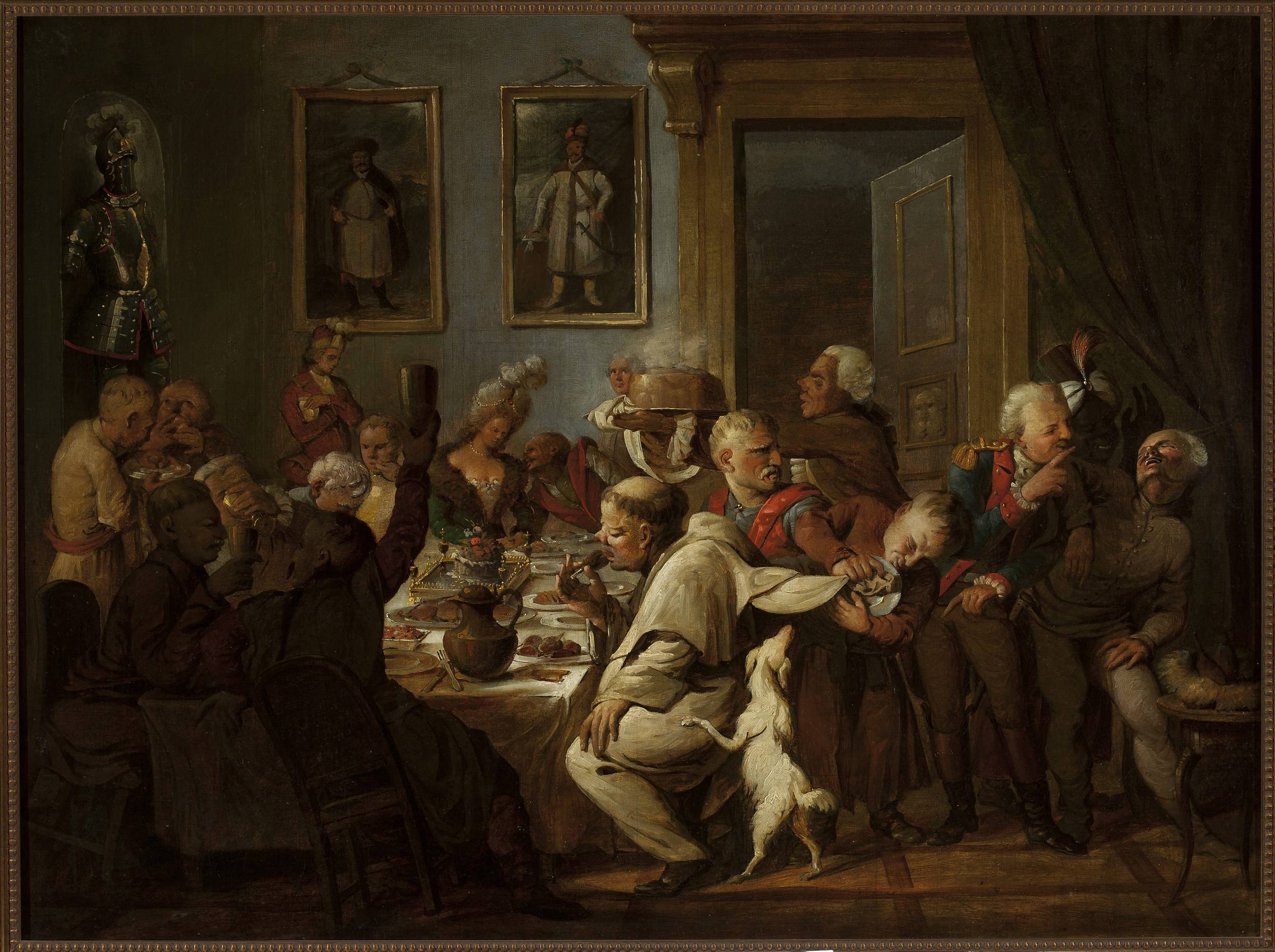
źródło: https://cyfrowe.mnw.art.pl/pl/katalog/508893
6) Pomidory w puszce!
Escoffier był pierwszym kucharzem, który starał się o stworzenie metody, dzięki której będzie można „zapuszkować” mięsa, sosy i warzywa. Wyobrażasz sobie, jak smutne musiało być życie bez pomidorów w puszce?
7) Napisał wiele artykułów i książek kulinarnych
Do najbardziej popularnych zalicza się: „La Guide Culinaire” oraz „A guide to Modern Cookery”.
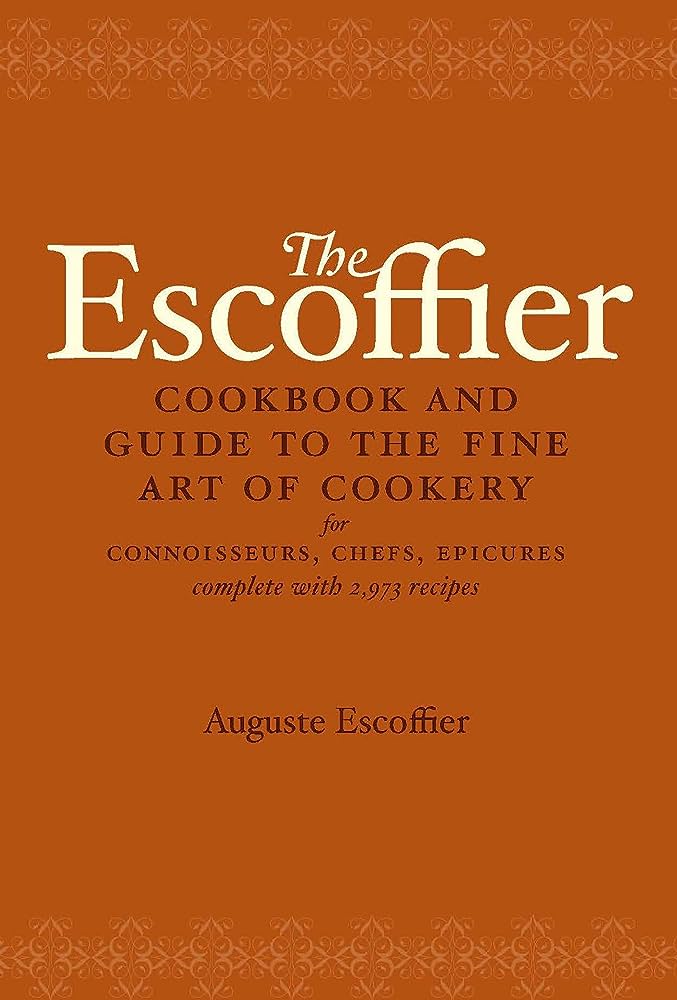
źródło: amazon.pl
8) Stworzył określenie dla pięciu sosów podstawowych – „5 sosów matki” – które stanowią bazę wyjściową dla innych sosów
Na początku XIX wieku, Chef Marie-Antoine Carême określiła cztery podstawowe sosy kuchni francuskiej. Auguste Escoffier rozszerzył jej teorię o jeden sos, zmienił nieco ich skład i określił je, jako „5 sosów matki”. Stanowią one bazę dla wielu innych sosów. Należą do nich:
Beszamel – składa się z mleka, masła i mąki, soli, białego pieprzu oraz gałki muszkatołowej. Do zasmażki z masła i mąki stopniowo dodajemy ciepłego mleka. Gdy uzyskamy odpowiednią konsystencję – przyprawiamy. Znamy go m.in. z lasagne i zapiekanek mięsno-warzywnych.
Sos Hiszpański – często nazywany jest po prostu brązowym sosem. Składa się z masła, mąki, ciemnego bulionu (gotowanego na podsmażonych kościach wołowych), mirepoix (mieszanki posiekanych marchewek, selera i cebuli) oraz przecieru pomidorowego. Najczęściej podawany z czerwonym mięsem.
Sos Holenderski – jedyny sos bez zasmażki. Żółtka ubijamy z masłem klarowanym, cytryną, solą i białym pieprzem. Osobiście do tego sosu dodaję również odrobinę białego wina. Holender idealnie komponuje się z jajkami na twardo i szparagami.
Sos Pomidorowy – jego podstawą jest intensywny bulion wołowy, ciemna zasmażka (mąkę praży się na sucho i gdy ściemnieje, dodajemy masła i intensywnie mieszamy, aż uzyskamy brązowy kolor) i oczywiście pomidory, a dokładniej przecier pomidorowy. Nie jest to sos, który kojarzymy z nazwą „pomidorowy”. Jest on bazą do sosów właściwych.
Sos Velvet (Velouté) – robi się go podobnie do beszamelu, tylko zamiast mleka dodajemy jasny bulion (najczęściej drobiowy, warzywny lub rybny).
9) Znał umami, kiedy jeszcze nie wiadomo było, czym ono jest
Ten piąty smak nazywał „wyśmienitością”. Najlepiej opisuje to fragment z książki „Białe trufle” autorstwa N.M.Kelby:
– Wyśmienite – powtarzała raz za razem, aż w końcu Escoffier nie mógł dłużej tego znieść.
– Nie, nie jest wyśmienite. Ma w sobie to, co nazywam wyśmienitością. Piąty smak. Gorzki, słony, kwaśny, słodki i wyśmienitość. Mówię o tym ludziom, a oni myślą, że to tylko mój wymysł, ale wyśmienitość jest na Twoim języku, jest tam celowo. Potrzebujesz jej, żeby docenić wywar cielęcy. Nadejdzie dzień, kiedy wszyscy ją odkryją.
I teraz pytanie za 100 punktów:
Dlaczego nie wszyscy ludzie na świecie znają postać Auguste Escoffiera?
Przecież tak wiele mu zawdzięczamy. Stworzył kilkanaście tysięcy receptur, całkowicie zmienił sposób postrzegania kucharzy i serwowanych dań. Dzięki niemu jedzenie stało się sztuką, a nie prostym rzemiosłem.
Najlepszym zakończeniem tej myśli będzie kolejny cytat z „Białych Trufli”:
– Zwyczaj noszenia toczków kucharskich zapoczątkował mistrz Marie Antoine Careme. Chronią włosy przed ogniem i określają rangę. Saucier i piekarz noszą proste, niewielkie toczki, mistrz nadzorujący pracę mały toczek zakładkami, natomiast szef kuchni musi utrzymać na głowie wykrochmalony, śnieżnobiały toczek z tyloma zakładkami, na ile sposobów potrafi przyrządzić jajko. Każdy wie, że wszystko podlega temu człowiekowi. Jego toczek jest najwyższy ze wszystkich.
– Więc czemu Ty takiego nie nosisz?
– Mam. Ale prawdę mówiąc, noszenie toczka jest dla mnie poniżające. Większość osób zna tylko sto sposobów na przyrządzenie jajka, dlatego przyjęto sto jako maksymalną liczbę zakładek. Ja znam sześćset osiemdziesiąt pięć sposobów, więc noszenie toczka naraża mnie na kompromitację, a na to nie mogę się zgodzić.
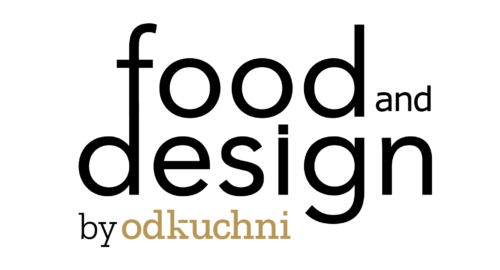

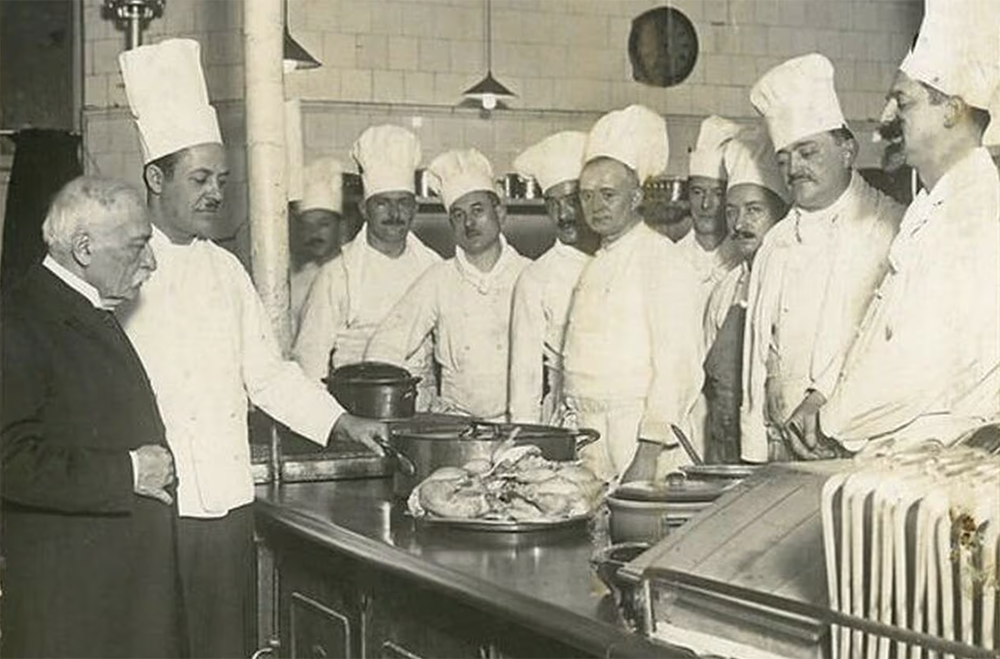




![Guest experience i pojęcie hospitality okiem eksperta: Antoine Azaïs [wywiad] FOOD AND DESIGN - zdjęcia do artykułów (12)](https://foodanddesign.pl/wp-content/uploads/2024/05/FOOD-AND-DESIGN-zdjecia-do-artykulow-12-580x420.png)
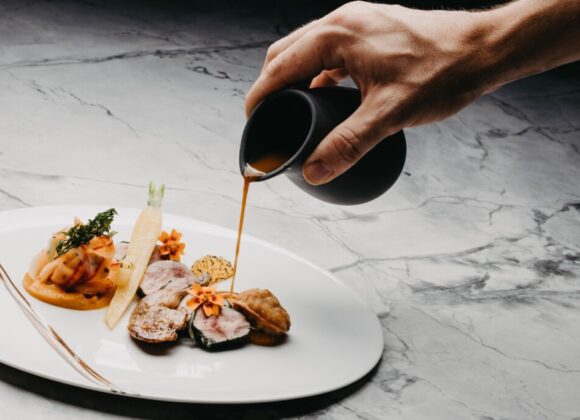


 Młodszy specjalista ds. komunikacji marketingowej i PR.
Młodszy specjalista ds. komunikacji marketingowej i PR.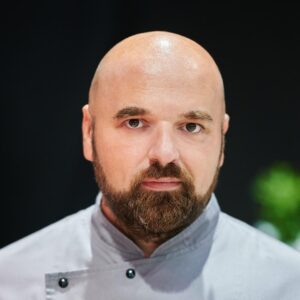


 Absolwent Uniwersytetu Warszawskiego oraz Szkoły Głównej Gospodarstwa Wiejskiego. W branży HoReCa od ponad 10 lat. Przez lata związany z Grupą Trip, Sobienie Królewskie Golf and Country Club oraz restauracją Florentin w Warszawe.
Absolwent Uniwersytetu Warszawskiego oraz Szkoły Głównej Gospodarstwa Wiejskiego. W branży HoReCa od ponad 10 lat. Przez lata związany z Grupą Trip, Sobienie Królewskie Golf and Country Club oraz restauracją Florentin w Warszawe. Absolwentka Wydziału Architektury Politechniki Warszawskiej na kierunku Architecture for Society of Knowledge oraz Komunikacji Wizualnej na Politecnico di Milano. Specjalistka od budowania nastroju. Doświadczenie zdobywała w kraju i zagranicą podczas licznych warsztatów międzynarodowych (Sevilla, Lizbona, Florencja), stypendium na La Sapienza (Rzym) oraz pracując m.in. w Carmi e Ubertis i ADM Milano.
Absolwentka Wydziału Architektury Politechniki Warszawskiej na kierunku Architecture for Society of Knowledge oraz Komunikacji Wizualnej na Politecnico di Milano. Specjalistka od budowania nastroju. Doświadczenie zdobywała w kraju i zagranicą podczas licznych warsztatów międzynarodowych (Sevilla, Lizbona, Florencja), stypendium na La Sapienza (Rzym) oraz pracując m.in. w Carmi e Ubertis i ADM Milano.








 Menedżer z wieloletnim doświadczeniem w branżach kosmetycznej, spożywczej, dziecięcej. W trakcie swojej kariery związany z firmami takimi jak: L’Oreal, Samsung, Danone-Nutricia, Unilever. W ciągu swojego życia zawodowego odpowiadał między innymi za rozwój sprzedaży i contentu eCommerce w Polsce i krajach Europy Środkowo-Wschodniej.
Menedżer z wieloletnim doświadczeniem w branżach kosmetycznej, spożywczej, dziecięcej. W trakcie swojej kariery związany z firmami takimi jak: L’Oreal, Samsung, Danone-Nutricia, Unilever. W ciągu swojego życia zawodowego odpowiadał między innymi za rozwój sprzedaży i contentu eCommerce w Polsce i krajach Europy Środkowo-Wschodniej. 

























































